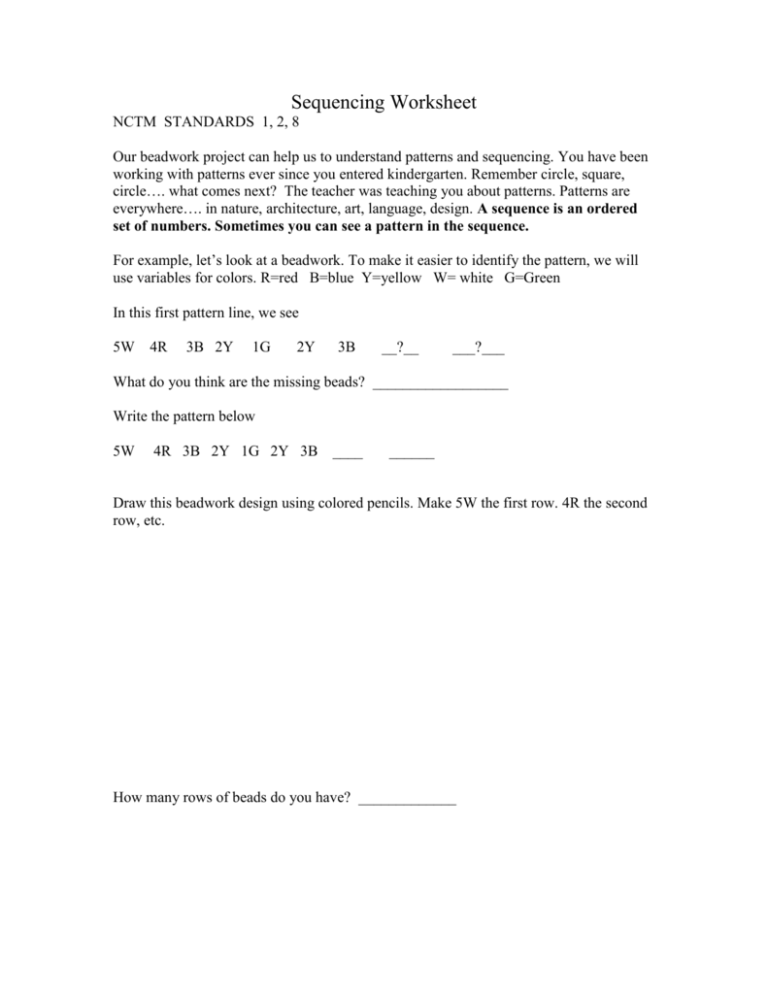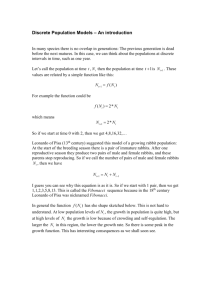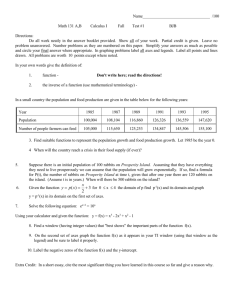Sequencing Worksheet
advertisement

Sequencing Worksheet NCTM STANDARDS 1, 2, 8 Our beadwork project can help us to understand patterns and sequencing. You have been working with patterns ever since you entered kindergarten. Remember circle, square, circle…. what comes next? The teacher was teaching you about patterns. Patterns are everywhere…. in nature, architecture, art, language, design. A sequence is an ordered set of numbers. Sometimes you can see a pattern in the sequence. For example, let’s look at a beadwork. To make it easier to identify the pattern, we will use variables for colors. R=red B=blue Y=yellow W= white G=Green In this first pattern line, we see 5W 4R 3B 2Y 1G 2Y 3B __?__ ___?___ What do you think are the missing beads? __________________ Write the pattern below 5W 4R 3B 2Y 1G 2Y 3B ____ ______ Draw this beadwork design using colored pencils. Make 5W the first row. 4R the second row, etc. How many rows of beads do you have? _____________ There are two patterns working here. The color and the number. 5, 4, 3, 2, 1, 2, 3, 4, 5 WRBYGYBRW Notice that the upper half reflects the lower half around the bead row 1G. We say that this is the line of symmetry for this design. In other words, what is above this line looks just like what is below this line. Does your beadwork have a reflection line? _______________ Draw your beadwork design that you created on your hand-made loom. Use colored pencils to indicate color. Draw and label the reflection line. Find the missing numbers in the following sequences. 5, 7, 9, ____, 13, _____ ____, _____, 24, 20, ____, 12 6, 11, ____, 21, _____, ______ _____, 12, _____, 4, 3, 2 1, 1, 2, ____,5, _____ ____, 97, 80,______, 46 2, 3, 5, 7, _____, ______ Each number in the sequence is called a term of the sequence. If there are dots behind the last number written, it means that the sequence goes on forever. For example, 3, 5, 7, 9 …. Some sequences have rules which describe what is happening in the sequence. Not all sequences have rules. Look at your beadwork, do you see a pattern or sequence? _____________ If so, what is the pattern? ____________________ Does your pattern have a rule that you can write so that other students could add to your pattern. The rule would describe what comes next. For example, lets look at a sequence. 4, 8, 12, 16, 20, 24…. Suppose I was making this beautiful sequence in my beadwork. I started a row with 4 red beads. The next row I put 8 red beads, then 12 and so on. When I got to the 7th row, I need to figure out how many beads should go in that row and not break the pattern I am creating. If I look at the sequence, I can notice that a tern is four more than the previous term. The rule would be to add four. So the next row would have 28. Returning to your beadwork, do you see a rule in how you distributed your beads? Describe the rule. _________________________________________________________________ Leonardo Fibonacci was a famous mathematician during the Middle Ages. He was very interested in patterns and sequencing.. One day Fibonacci was thinking about rabbits. He wondered if there was a way to predict how many pairs of rabbits could be produced from a single pair of rabbits in a year. Every month after their first month of life each pair of rabbits produced a new pair. This problem gave rise to the famous Fibonacci sequence. In the first month you have one pair of rabbits and they can not produce until the second month of life. So we have 1 to start, 1 in the first month. 1, 1 The second month they produce a pair of rabbits. So now there are two pairs. 1, 1, 2 The second pair can not reproduce for a month, but the first pair can reproduce. So in the fourth month we have 3 pairs. 1, 1, 2, 3 Now in the fifth month both the first and second pair can reproduce but the third pair must wait a month. Now we have 1, 1, 2, 3, 5 Continue this sequence. How many pairs of rabbits will we have in the 6th month? Show your work. Finish the sequence for the entire year. 1, 1, 2, 3, 5, ____, _____, _____, _____, ______, _______, ________ So in this case, how many rabbits very produced from a single pair of rabbits in a year? __________ Can you think of any reasons why this number might not be the actual number you count if you had this happening in your backyard? ________________________________________________________________________ ________________________________________________________________________ Do you see a rule for this Fibonacci sequence? What is the rule? ___________________________________________________ Sequencing is important to us in understanding how things work, in predicting future outcomes, in games and logic and in art. If you look at something as simply as logs being transported by truck. Logs are stacked in a triangular pattern similar to an arrangement of bowling pins. Why do you think they are stacked this way? _____________________________________________________________________ _____________________________________________________________________ If you were a foreman and piling telephone poles on a truck. Do you know how many poles you would have on the truck if the bottom layer had 30, the next layer had 29, and so on until there is one pole in the top layer? _____________________ When you enter Algebra 2, you will learn a lot more about sequencing and series. You will learn how to find a general term for a sequence. You will learn how to write your rules describing the nth term. And you will learn about Arithmetic and Geometric sequences and series.






